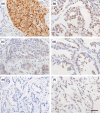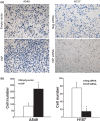Overexpression of yes-associated protein contributes to progression and poor prognosis of non-small-cell lung cancer
- PMID: 20219076
- PMCID: PMC11158334
- DOI: 10.1111/j.1349-7006.2010.01511.x
Overexpression of yes-associated protein contributes to progression and poor prognosis of non-small-cell lung cancer
Abstract
Yes-associated protein (YAP), the nuclear effector of the Hippo pathway, is a key regulator of organ size and a candidate human oncogene. This study aimed to assess the clinical significance and biological functions of YAP in non-small-cell lung cancer (NSCLC). We investigated the expression of YAP in 92 cases of NSCLC tissue by immunohistochemistry and found that YAP was expressed in 66.3% (61/92) cases and predominantly presented in the nucleus. The expression of YAP in NSCLC was significantly correlated with p-TNM stage (P = 0.0037) and lymph node metastasis (P = 0.0093). Importantly, YAP expression was associated with short overall survival. Further study in NSCLC cell lines in which YAP was either overexpressed or depleted confirmed that YAP markedly promoted cell proliferation and invasion. These results indicate that YAP plays an important role in NSCLC and might be a useful therapeutic target of NSCLC.
Figures







Similar articles
-
Expression of LATS1 contributes to good prognosis and can negatively regulate YAP oncoprotein in non-small-cell lung cancer.Tumour Biol. 2014 Jul;35(7):6435-43. doi: 10.1007/s13277-014-1826-z. Epub 2014 Mar 29. Tumour Biol. 2014. PMID: 24682895
-
Rab11a promotes proliferation and invasion through regulation of YAP in non-small cell lung cancer.Oncotarget. 2017 Apr 25;8(17):27800-27811. doi: 10.18632/oncotarget.15359. Oncotarget. 2017. PMID: 28468127 Free PMC article.
-
Inhibition of CXCR4 regulates epithelial mesenchymal transition of NSCLC via the Hippo-YAP signaling pathway.Cell Biol Int. 2018 Sep;42(10):1386-1394. doi: 10.1002/cbin.11024. Epub 2018 Jul 17. Cell Biol Int. 2018. PMID: 29972256
-
Epidermal Growth Factor Receptor (EGFR) Pathway, Yes-Associated Protein (YAP) and the Regulation of Programmed Death-Ligand 1 (PD-L1) in Non-Small Cell Lung Cancer (NSCLC).Int J Mol Sci. 2019 Aug 5;20(15):3821. doi: 10.3390/ijms20153821. Int J Mol Sci. 2019. PMID: 31387256 Free PMC article. Review.
-
Clinicopathological and prognostic value of S100A4 expression in non-small cell lung cancer: a meta-analysis.Biosci Rep. 2020 Jul 31;40(7):BSR20201710. doi: 10.1042/BSR20201710. Biosci Rep. 2020. PMID: 32696952 Free PMC article.
Cited by
-
Comparative interactome analysis of α-arrestin families in human and Drosophila.Elife. 2024 Jan 25;12:RP88328. doi: 10.7554/eLife.88328. Elife. 2024. PMID: 38270169 Free PMC article.
-
YAP promotes erlotinib resistance in human non-small cell lung cancer cells.Oncotarget. 2016 Aug 9;7(32):51922-51933. doi: 10.18632/oncotarget.10458. Oncotarget. 2016. PMID: 27409162 Free PMC article.
-
Regulation of TAZ in cancer.Protein Cell. 2016 Aug;7(8):548-61. doi: 10.1007/s13238-016-0288-z. Epub 2016 Jul 14. Protein Cell. 2016. PMID: 27412635 Free PMC article. Review.
-
Distinct immunological properties of the two histological subtypes of adenocarcinoma of the ampulla of Vater.Cancer Immunol Immunother. 2019 Mar;68(3):443-454. doi: 10.1007/s00262-018-02293-6. Epub 2019 Jan 2. Cancer Immunol Immunother. 2019. PMID: 30604042 Free PMC article.
-
Role of YAP in lung cancer resistance to cisplatin.Oncol Lett. 2018 Sep;16(3):3949-3954. doi: 10.3892/ol.2018.9141. Epub 2018 Jul 12. Oncol Lett. 2018. PMID: 30128013 Free PMC article.
References
-
- Minna JD, Roth JA, Gazdar AF. Focus on lung cancer. Cancer Cell 2002; 1: 49–52. - PubMed
-
- Jemal A, Siegel R, Ward E, Murray T, Xu J, Thun MJ. Cancer statistics, 2007. CA Cancer J Clin 2007; 57: 43–66. - PubMed
-
- Schiller JH, Harrington D, Belani CP et al. Comparison of four chemotherapy regimens for advanced non‐small‐cell lung cancer. N Engl J Med 2002; 346: 92–8. - PubMed
-
- Huang J, Wu S, Barrera J, Matthews K, Pan D. The Hippo signaling pathway coordinately regulates cell proliferation and apoptosis by inactivating Yorkie, the Drosophila Homolog of YAP. Cell 2005; 122: 421–34. - PubMed
MeSH terms
Substances
LinkOut - more resources
Full Text Sources
Other Literature Sources
Medical

